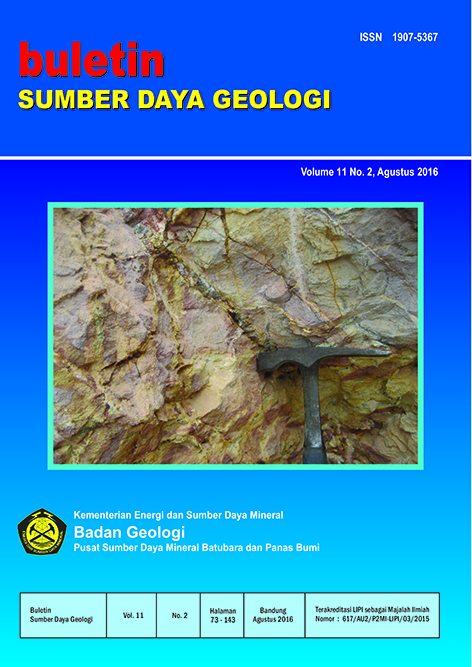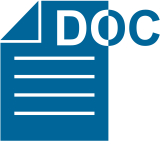KARAKTERISTIK BATUAN INDUK HIDROKARBON DAN HUBUNGANNYA DENGAN REMBESAN MINYAK DI LAPANGAN MINYAK CIPLUK, KABUPATEN KENDAL, PROVINSI JAWA TENGAH
Abstract
Lapangan minyak Cipluk di Cekungan Serayu Utara merupakan lapangan minyak tua jaman Belanda yang telah ditinggalkan, dan belum pernah dilakukan analisis geokimia minyak atau batuan yang diduga sebagai batuan sumber. Tujuan penelitian ini adalah untuk mengetahui karakteristik batuan induk dari Formasi Kerek dan Formasi Penyatan dan hubungannya dengan rembesan minyak bumi di Sojomerto. Metodologi yang dilakukan adalah penelitian lapangan dan analisis laboratorium. Dari analisis batuan induk diperoleh nilai Kandungan Organik Karbon (TOC) yang berkisar dari 0,72% sampai 7,97%, yang menunjukan kategori sedang hingga sangat baik untuk mampu membentuk hidrokarbon. Berdasarkan pirolisis rock eval tingkat kematangan thermal dari conto berada dalam kisaran belum matang hingga matang, sedangkan tipe kerogennya termasuk ke dalam tipe III. Hasil analisis geokimia conto minyak menunjukan minyak yang telah mencapai tingkat matang, batuan induk minyak diendapkan pada lingkungan estuarin atau lakustrin dangkal dengan material organik yang berasal dari tumbuhan daratan. Rembesan minyak di Sojomerto tidak mempunyai korelasi geokimia dengan conto batuan induk dari Formasi Kerek atau Formasi Penyatan.
Downloads
References
Connan J. and Cassou, A.M., 1980, Properties of gases and petroleum liquids derived from terrestrial kerogen at varios maturation levels. Geochemical Cosmochim. Acta 44, 1-23.
Cox, H.C., Leeuw, J.W., Schenk, P.A. et al., 1986. Bicadinane, a C30 pentacyclic isoprenoid hydrocarbon found in crude oil. Nature, pp. 316-319.
Hidayat R. dan Fatimah, 2007, Inventarisasi Kandungan Minyak dalam Batuan Daerah Kedungjati, Kabupaten Semarang, Provinsi Jawa Tengah. Proceeding Pemaparan Hasil Kegiatan Lapangan dan Non Lapangan Tahun 2007. Pusat Sumber Daya Geologi. 13 hal.
Mukhopadhyay, P. K., Wade J.A., Gruge M. A., 1995, Organic facies and maturation of Jurassic/ cretaceous rocks, and possible oil-source rock correlation based on pyrolysis of asphaltenes, Scotian Basin Canada, Org. Geochem., Vol. 22, No.1, pp. 85- 104.
Peters, K.E., 1986, Guidlines for evaluating petroleum source rock using programmed pyrolysis. American
Association of Petroleum Geology, Bulletin, 70, p.1-36.
Peters, K.E. and Moldowan, J.M., 1993, The Biomarker Guide. Interpreting Molecular Fossils in Petroleum and Ancient Sediments, Prentice Hall, New Jersey, 363pp.
Satyana, A.H., Armandita C., 2004. Deepwater Plays of Java, Indonesia: Regional Evaluation on Opportunities and Risks. Proc. Deepwater And Frontier Exploration In Asia & Australasia Symposium, Indonesian Petroleum Association.
Thanden R.E., Sumadirdja H., Richards P.W., Sutisna K., dan Amin T.C., 1996, Peta Geologi Lembar Magelang dan Semarang. Skala 1:100.000. Pusat Penelitian dan Pengembangan Geologi.
Tissot, B.P. and D.H.Welte, 1984, Petroleum formation and occurrence, Springer Verlag, Berlin, 699 pp.
Waples D.W. (1985), Geochemistry in Petroleum Exploration, International Human Resources Developmen Co., Boston.
Waples, D.W. and Machihara, 1991. Biomarker for Geologist-A Practical Guide to the Application of Steranes and Triterpanes in Pe¬troleum Geology. American Association of Petroleum Geologists. Methods in Exploration Series, 9, 91pp.
Copyright (c) 2017 Buletin Sumber Daya Geologi

This work is licensed under a Creative Commons Attribution-NonCommercial-ShareAlike 4.0 International License.
Authors whose manuscripts are published agree to the following terms:
The publication rights of all journal manuscript materials published on the Buletin Sumber Daya Geologi website are held by the editorial board with the knowledge of the author (moral rights remain with the manuscript’s author).
The formal legal provisions for access to digital articles in this electronic journal are subject to the terms of the Creative Commons Attribution-ShareAlike (CC BY-SA) license. This means that Buletin Sumber Daya Geologi has the right to store, convert media/formats, manage in the form of a database, maintain, and publish the article without requesting permission from the author, as long as the author’s name is cited as the copyright holder.
Manuscripts published in both print and electronic formats are open access for educational, research, investigative, and library purposes. Beyond these purposes, the editorial board is not responsible for any violations of copyright law.















